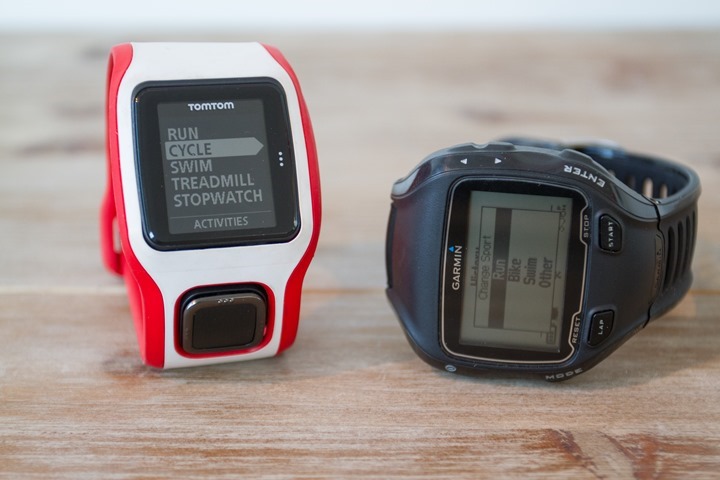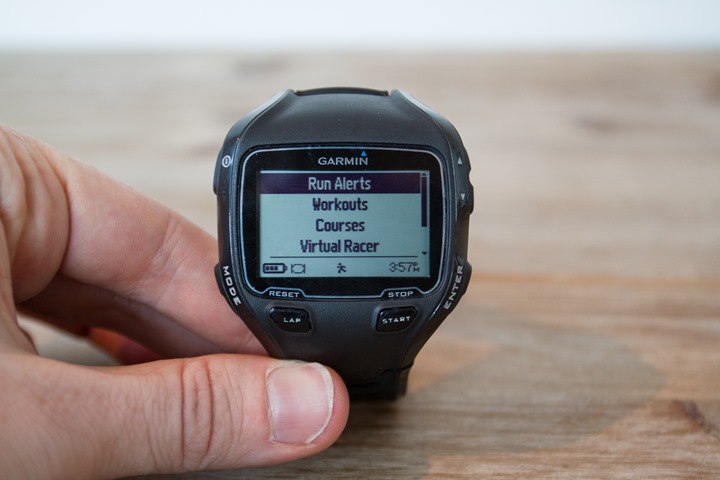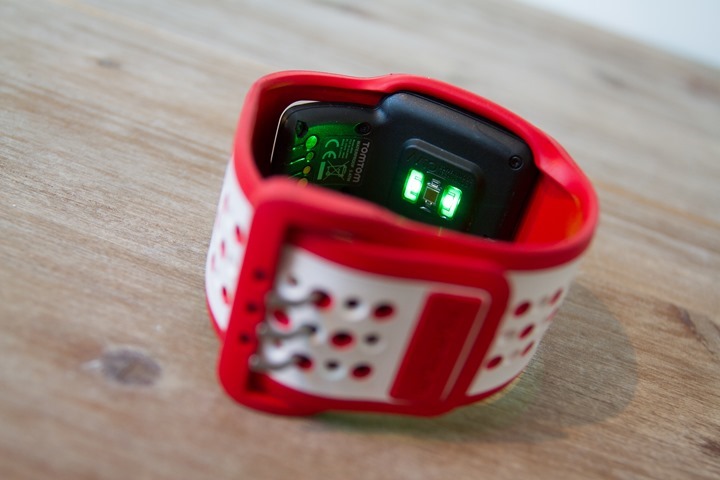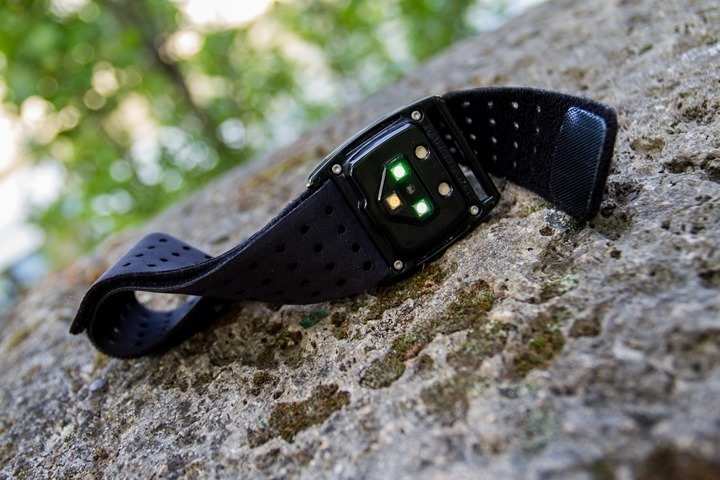Starting today, a handful of products are on a fairly big sale – the Garmin FR910XT, TomTom Runner Cardio, and a deal with the Scosche Rhythm+. As is usually the case, I tend not to create standalone posts on any sales unless it’s a pretty big sale and worthy of noting.
Garmin FR910XT Sale:
Here’s the simplified version of what’s on sale, starting with the Garmin Forerunner 910XT multisport watch deal:
Garmin FR910XT Base: Now $249US (was $399US)
Garmin FR910XT with HR strap: Now $299 (was $449US)
Garmin FR910XT with HR strap, speed/cadence sensor, quick release kit: Now $349US (was $499US)
(Select dropdown for different bundles)
For the Garmin devices, the usual DCR 10% device savings doesn’t apply due to the sale nature. However, the free US shipping does apply – so still solid there.
With the Garmin sales, these are good from now until March 28th – and only through Clever Training. We tend to see these sorts of triathlon product focused sales each year from Garmin in the spring, so the presence of a sale isn’t too big a surprise. Additionally, with the FR920XT having come out last fall, and the Fenix3 now as well – the FR910XT is a bit older – though, still definitely quite capable.
As for the Garmin side and my guidance – here’s my thinking. First, obviously the FR910XT will not see any new feature updates, so definitely don’t expect that. At three years old, those dates are long behind us given the FR920XT & Fenix3 are out now.
But, that doesn’t mean the FR910XT is obsolete. I’d argue that from a feature standpoint it’s the most full featured triathlon product out there, except the FR920XT/Fenix3. By the same token, at $219US, the Suunto Ambit2 S is also a slamming deal, but lacks much (all) of the structured training that you see on the Garmin device. This means that while both devices can do swim/bike/run tracking, the FR910XT can do structured workouts, intervals, and the like. Whereas with the Ambit2 lineup none of that is really there. For some folks, that won’t matter much, and yet for others, it’ll matter quite a bit. Additionally, I’d give a significant edge to the Garmin lineup for power meter metrics support (the Ambit series is limited there). On the flipside, the Ambit series has much better support for courses, routing & navigational pieces than the FR910XT.
As for deciding whether or not one would get the FR920XT instead of the FR910XT – I’d say that’s primarily a budget based decision. No doubt that at the regular FR910XT price of $399, it’s highly overpriced (and I suspect we’ll see that drop in the months ahead). I think $249 is a fair price for it.
Of course, with the newer watches including the FR920XT, Fenix3, and Vivoactive you’re going to get Connect IQ support – which will open up the doors for lots of apps to provide features that Garmin doesn’t natively (or, just do certain features better). The app store really only just opened last week, but there’s already some good things coming out of that. Though, I suspect that’ll take some months to mature more.
Finally, for those that may want to compare the Vivoactive with the FR910XT, that’s definitely valid. Both are $249US in this scenario. However, keep in mind that the Vivoactive is unable to do a true multisport mode workout. It also doesn’t support openwater swimming (it does support pool swimming). And, it lacks structured workouts today – though, that could be fixed via Connect IQ. And, it’s possible the others could be addressed via apps as well. But, I just don’t know if we’ll see that gap closed that way.
TomTom Cardio line-up:
Next up, is the TomTom Cardio lineup, including the TomTom Runner Cardio and Multisport Cardio.
These two watches are one of the few optical sensor GPS watches on the market, and realistically one of only two product lines on the market that actually has an optical sensor that works during sport use. If you compare it to something like the Fitbit Surge or some of the Soleus units – neither of those companies utilize optical sensors that work terribly well during activities.
The run-down on the deal here is slightly better than at first glance, because the DCR 10% coupon code DCR10BTF remains valid for these purchases. Plus, you get free US shipping. The below prices are prior to the 10% discount:
TomTom Runner Cardio: Now $219US (was $269US)
TomTom Multisport Cardio: Now $249US (was $299US)
TomTom Multisport Cardio Cycling Bundle (altimeter, cadence sensor + bike mount): Now $349 (was $399)
Now, then you’ll layer in the DCR 10% savings on top of that. So in the case of the Runner, you’re looking at $197, or basically $72 off.
So how does the Cardio line compare? Well, as per my recommendations in November – if you want an optical HR GPS watch, the TomTom Cardio lineup remains the best unit overall option. You do have the Adidas Smart Run GPS with integrated optical HR, but that’s a bit more pricey.
As for the multisport crowd – I generally don’t recommend the TomTom Multisport units as much, only because they lack a multisport mode as well as an openwater swim mode. So, for a pure triathlete…that’s kinda a substantial omission. Additionally, the web platform continues to lag just as some of the updates have been notably lacking. But, on the flip side, it gets optical HR right and GPS is accurate.
So I think the best option here out of the group on sale is really the Runner Cardio variant, since that doesn’t appeal to the multisport athlete but rather the runners. And in that area, it does really well.
Finally, the TomTom Cardio deals are good through Saturday, March 21st, so a bit shorter.
Scosche Rhythm+ optical HR sensor (dual ANT+/Bluetooth Smart):
Finally, we’ve got the Scosche Rhythm+ optical HR sensor, my favorite standalone optical HR sensor. The deal here is a bit more simplified, but probably still appeals to some. In this case, there’s no discount on the unit itself (aside from the usual DCR 10% discount), but you do get a free pair of headphones. It’s a similar promotion to back during the holidays, which you all seemed to like.
As noted in my device recommendations, the Scosche remains my favorite because I have the best results with it, and you as readers universally have had the best results with it (and about half of my family is using it too). It transmits on both ANT+ and Bluetooth Smart concurrently, so it’ll pair just fine with a Garmin watch or an app on your smartphone (or both at once). Basically almost every device out there will use one of those two protocols.
It’s typically worn on the upper arm, though you can be flexible on that. And unlike some other devices, it doesn’t have any transmission problems either.
As for the headphones, they are the Scosche Sport Clips 2. This deal is good until for about a week, or while supplies last. Like the TomTom deal, you can indeed use the DCR DCR10BTF coupon code.
–
With that – thanks for reading, and for supporting the site!
FOUND THIS POST USEFUL? SUPPORT THE SITE!
Hopefully, you found this post useful. The website is really a labor of love, so please consider becoming a DC RAINMAKER Supporter. This gets you an ad-free experience, and access to our (mostly) bi-monthly behind-the-scenes video series of “Shed Talkin’”.
Support DCRainMaker - Shop on Amazon
Otherwise, perhaps consider using the below link if shopping on Amazon. As an Amazon Associate, I earn from qualifying purchases. It doesn’t cost you anything extra, but your purchases help support this website a lot. It could simply be buying toilet paper, or this pizza oven we use and love.

























May want to mention some functions on some Garmin watches won’t work with the Scosche. (true many people might think those features don’t matter so it doesn’t matter)
Yeah, I figured that folks that were interested in them would probably dive into the reviews of either where I talk through some of that. As you noted, for many, the features that are impacted aren’t of too much concern.
For others who are curious, optical HR sensors aren’t super-accurate when it comes to heart rate variability (today in the industry, no matter the product, it’s a guesstimate). That can manifest itself on other devices (i.e. Garmin/Polar) in a variety of ways, but the most common is the recovery time calculations that depend on HRV/RR data. It can sometimes (rather rarely) also impact calories, but not very often. Finally, it can impact VO2Max calculations in some cases.
For some people, it’s perfectly fine and aligned, and for others not so much. For me, it’s a mix – sometimes it’s fine and for other activities it’s off. For me personally, I’ve never found a lot of value in either of those two metrics (Recovery Time or VO2Max).
Out of curiosity, do you have any data (or anecdotes) regarding reported calories burned when wearing an optical HRM vs. a HRM that can record HRV? Are they usually close? I always thought the reported number would be meaningless if the HRV is just made up/estimated, so I’m surprised to see you say it impacts it rather rarely.
Thanks.
I did some testing last fall a bit, mostly casual observations. From a calorie count standpoint, they’re usually quite close for the devices I was looking at (mostly Garmin). I suspect there’s less of a dependency on HRV for those calculations.
There were some initial growing pains with various (very specific) devices when the Scosche first came out, but Scosche has kept on moving to ensure virtually every device out there is compatible. They’ve also on-demand (for free) swapped out any older devices if you happen to stumble into an incompatibility.
I keep meaning to show some fun charts I’d been collecting of HRV data recorded at the same time from numerous sources (various optical, multiple chest, helmet, etc…). I used the WASP tool to collect it last year after I asked them to add support for it. Just a lot of data to sift through more than anything else right now (and backlogged since there tends to be less interest in HRV).
Thanks a lot; that data would be interesting to see. The estimated calories burned isn’t a huge point for me (I get by just fine now calculating it manually), but it would be convenient to have it automatically synced with my myfitnesspal. I’m still deciding between a chest strap and an optical sensor but it seems like the chest strap doesn’t actually have as much of an advantage for this application as I thought it would.
Damn. Just ordered the TomTom Runner Cardio yesterday. Guess I will have to call them and see if they will honor the sale price. Thanks for the heads up.
Given you could technically cancel and re-order, I suspect they’ll help ya out. 🙂
Yep. They did – although they tried to say I couldn’t use the discount code with the sale price. I pointed out that the website would allow it so they politely and quickly refunded the entire $45 difference.
Thanks again!
Any idea on whether the TomTom deal is a sign that perhaps a new model is coming out soon or just an effort to be cost competitive against the slew of new watches?
I suspect more of a regular sales cycle. They did the same thing around this time last year. Seems to be once every 3-5 months.
Is the timex one gps+ any good? I’m currently looking for a gps + mp3 and heart rate sensor (optional) i do 5km to 10km regularly. Any suggestions?
It’s targeted at running, I’ve just started poking at it though. Probably another week or so until I can fully formulate opinions.
Hi,
I’m just willing to buy the HR straps from the 910xt if still available ?
Garmin still sells the HR straps for the FR910XT, as it’s the same HR strap used by all their products. Any ANT+ HR strap will work.
Additional….REview: in my experience Schosch Rythm+ nice dual band but accuracy and picking up consistent hr is a pain in the Ars. I no long use. I purchased a Mio Link (special edition on sale!) dual band it has great consistency and picks up hr with ease.
Can the tomtom be set for kilometers vs miles like my garmin can?
Yup.
Could you please recommend or point me in the right direction for one or a couple all day fitness trackers that play nice with the scosche rhythm+? I purchased and returned both the charge hr and surge and have read your entire scosche rhythm+ review. I love the SR+ accuracy and I can wear it on bicep for volleyball. My wishlist is something with accurate distance calculations (with calibration or gps) for everyday walking and treadmill running (footpad?), resting heart rate, calorie calculations and sleep tracking.
Thank you very much in advance,
Jack
jackhaze@gmail.com
I’d look at something like the Garmin FR15 or Polar M400. The M400 will shortly get footpod support, and the F15 already has it. Neither will capture resting heart rate as part of an application, but you can easily do that from your phone with an app and the Scosche.
The tomtom runner has the Garmin beat in two areas in my opinion.
1. the vibration feature is much more stronger on the Tomtom. I’m a fairly light sleeper and the Tomtom woke me up every day I had the alarm set. I got a Garmin 920 from CT and it seems the vibration motor is not as strong.
2. the Tomtom alarm has a snooze feature which I loved. The Garmin is one alarm and done. I hate that.
I know these are really minor. 🙂
I’d be really happy to see the data/report about HRV. I currently use a wahoo dongle and sweetbeat with my iPhone 4s to track HRV.
Can th optical schosche be used for HRV either with or with out the wahoo doohickey?
No, I wouldn’t use the HRV data from the Scosche (or any optical sensor) for any detailed HRV related analysis. It’s mostly estimated filler data to comply with the spec.
Great site. Friend just turned me on to it. After decades with Polar (most recently RS 300x) and tired of how often the band has to be replaced, I wanted to switch to Garmin and actually bought the Forerunner 220. However, once I got it home, I discovered that contrary to what three different customer service reps had told me, I could not download time spent in each of the five heart rate zones during a race or training. It allows one to set them, but that is useless to me if I can’t download time spent in each zone. I actually only need three zones. So I returned the Garmin.
So I’m wondering if you can recommend to this xc ski racer a watch, hr monitor and gps that will allow me to see the following: A. During training: 1. elapsed time, overall or lap, 2. Heart Rate, 3. Either time of day or distance.
B. Download after: 1. Avg. heart rate, 2. Max HR for both total time and each lap (or interval), 3. Time spent in at least 3 different HR zones during total time, 4. Distance during total time.
I’m not a triathlete, and I don’t care about the watch giving training suggestions or calories or anything other than what I have listed above, although I realize to get what I want I’ll have to pay for some features I’ll never use.
I’d really appreciate any help you can give me. Thanks.
The only thing you can’t do on the above is display time in zones on the unit itself (Garmin 910XT). The TomTom can display time in zones, and you can double-check the review, but off the top of my head it can do all of those metrics except Max HR on the unit itself.
Thanks.
I’ve been following your website for quite some time now and ended up ordering my first multisport watch, the forerunner 910xt, as a result of this deal. Cheers Ray!
Thanks for the support Riku!
They might as well see as many as they can now because once Apple Watch comes out next month they are done.
I enjoy running and mixing it up with some cross fit type workouts. I’m looking for a watch with a really good HR monitor but would also like to have GPS. I have read so much I am confused. I would love for the HR monitor to work while swimming. Please help! Thanks!
The challenge is the HR while swimming piece. That’s where it gets complicated, as some watches kinda work (TomTom Cardio), but without swimming distance details in that mode. Otherwise, for cross fit workouts, almost all of the major brands will use HR during a workout to determine calorie burn (i.e. Garmin, Polar, Suunto). You may want to check out my general recommendations here: link to dcrainmaker.com
Thanks so much for the heads-up. I had been thinking about the TomTom Runner Cardio and am thrilled to pick one up for $198.
I am a casual runner who keeps fit with 10 mile and half-marathons, but having recently turned 40, I got more interested in keeping an eye on HR. I wanted to upgrade from my basic Garmin FR10 to a watch that could do on-wrist HR (I don’t like chest straps.) For Christmas, I told my wife to buy me the Microsoft Band because it looked interesting, but the Band has been a nightmare: slow GPS acquisition, GPS fall-out, poor partner app integration and bluetooth connectivity challenges. Multiple chats with Microsoft support aren’t making this thing better. The Band is definitely still in beta. Hoping for a more straightforward experience with TomTom, and I know RunKeeper and Strava will easily sync runs, so I’m already ahead of the game compared to where I am right now.
Thanks again. –MB